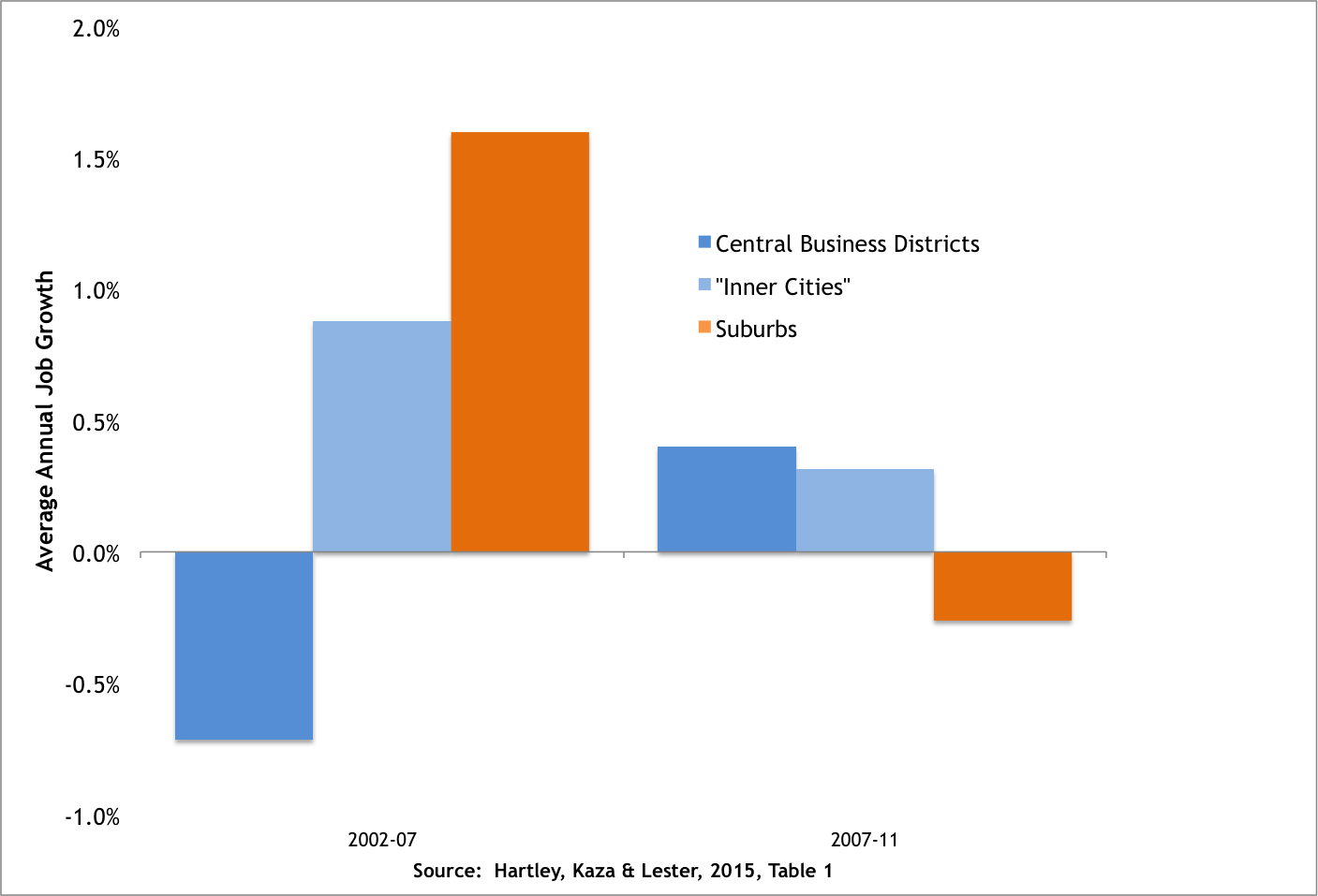In February, we released our latest CityReport Surging City Center Job Growth, presenting evidence showing employment growing faster in the city centers of the nation’s largest metros since 2007. Another set of analysts has, independent of our work, produced findings that point to renewed job growth in the nation’s inner city neighborhoods.
A new report issued by the Federal Reserve Bank of Cleveland, using similar data but different definitions reaches many of the same conclusions. The analysis, prepared by Fed Economist Daniel Hartley and Nikhil Kaza and T. William Lester of the University of North Carolina, is entitled Are America’s Inner Cities Competitive? Evidence from the 2000s. The Fed study divides metropolitan areas into three parts: the central business district (CBD)–a series of tracts that form the core of the commercial area in each metro’s largest city–the inner city–tracts within a principal city but outside the central business district (CBD), and the suburbs–the remainder of metro area.
Between 2002 and 2011, Hartley, Kaza and Lester report that inner cities have added 1.8 million jobs. They also echo one of our key findings: that job growth in city centers was stronger in the post-recession period than it was earlier in the decade. In the aggregate, inner cities recorded relatively robust job growth over the past decade (up 6.1% between 2002 and 2011) compared to suburbs (6.9%), and that particularly since the end of the recession (i.e. 2009) have recorded faster job growth (3.6%) than either suburbs (3.0%) or central business districts (2.6%).
To get a sense of how the geography of job growth has shifted over the past decade, its useful to divide the data roughly in half, comparing growth trends in the 2002-07 period (during the height of the housing bubble) with the growth from 2007-11 (the period representing the collapse of the bubble, and the impact of the Great Recession, and the first years of recovery). These were the time periods used in our Surging City Center Job Growth report, and we’ve recalculated the Fed data to make it directly comparable to our analysis. The chart below shows the data from the Fed report and computes the average annual growth rate of jobs for central business districts, inner cities, and suburbs for these two time periods.
These data show that in the earlier time period, suburbs were outperforming cities; inner cities were growing about half as fast as suburbs and CBD employment was actually declining. From 2002 to 2007, the further you were from the center, the faster you grew. This relationship reversed in the latter 2007-11 period. Cities outperformed suburbs–suburbs saw a net decline in employment–and job growth was actually somewhat faster in the CBD than in inner cities. Despite the recession, CBD job growth was much stronger in the 2007-11 period (+0.3%) than it was in the earlier 2002-07 period (-0.7%). (Note that percentage figures in the following graph represent annualized growth rates.)

There are some key differences between the Fed study and our recent City Observatory report. Our definition of “city center” included all those businesses within three miles of the center of the central business district. Both studies are based on geographically detailed employment data from the Census Bureau’s Local Employment and Housing Dynamics (LEHD) program. The new Fed study reports data for 281 US metropolitan areas (our report looked at 41 of the largest metropolitan areas).
The authors conclude that while it is too soon to term this an urban renaissance, its a noticeable change from the long term trend of employment decentralization. Though not universal, the pattern of strong inner city growth is widespread, with two-fifths (120 out of 281 metros) recording gains in overall employment and share of employment in inner cities. The traditional decentralizing pattern of employment still holds for some metropolitan areas, like Houston and Dallas, but inner cities are flourishing in some unlikely places, like heavily suburbanized Los Angeles and San Antonio.
As we did in our report, the authors of the Federal Reserve study examine the industrial dimensions of job change. Manufacturing jobs continue to suburbanize, and inner cities have been relatively more competitive for jobs in “eds and meds” education services and health care. They also identify a key role for the consumer city and population-led theories of urban growth. Within inner cities, job growth is positively associated with transit access and distance to the CBD, and seems to be driven more by population-serving businesses (like restaurants) than businesses dependent on infrastructure (manufacturing and distribution).
The full report has many more details, and identifies the metros with competitive inner cities (i.e. those places where inner city areas gained share of total metro employment between 2002 and 2011).
We’re expecting to get data for 2012 and 2013, to be able to judge whether these trends persisted as the US economy continued to recover. If you’re keenly interested in urban economies, as we are, you’ll be eagerly awaiting the new numbers. In the mean time, the Cleveland Fed study is a “must read.”
Hartley, Daniel A., Nikhil Kaza, and T. William Lester, 2015. “Are America’s Inner Cities Competitive? Evidence from the 2000s,” Federal Reserve Bank of Cleveland, working paper no 15-03. https://www.clevelandfed.org/en/Newsroom%20and%20Events/Publications/Working%20Papers/2015%20Working%20Papers/WP%2015-03%20Are%20Americas-Inner-Cities-Competitive-Evidence-from-the-2000s.aspx

